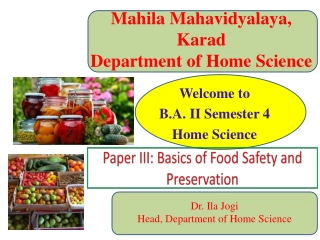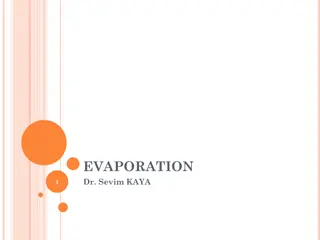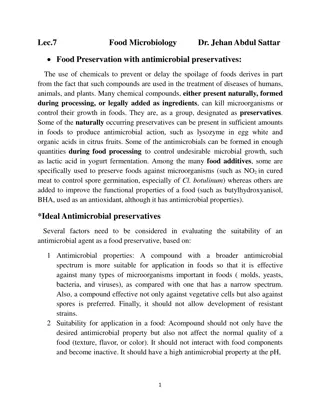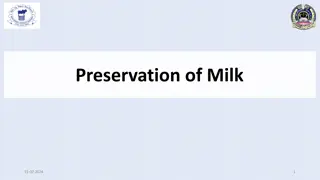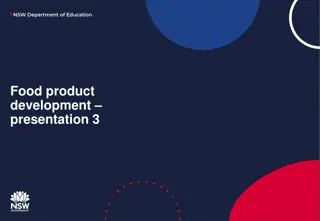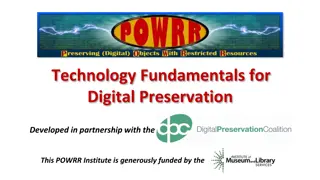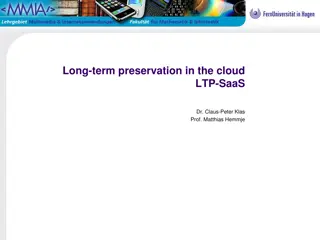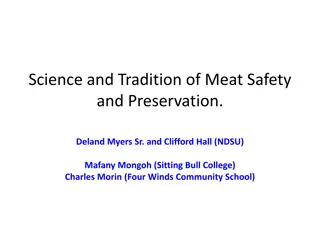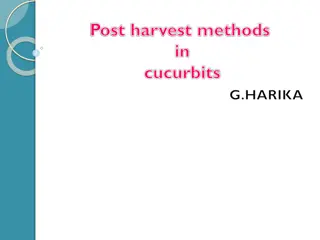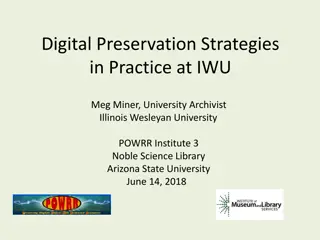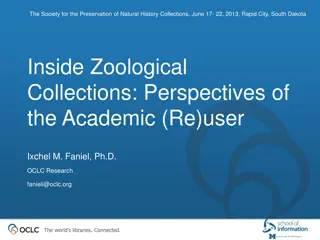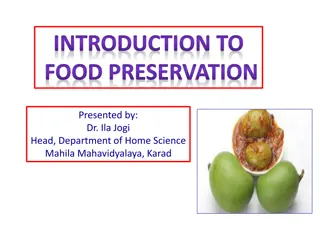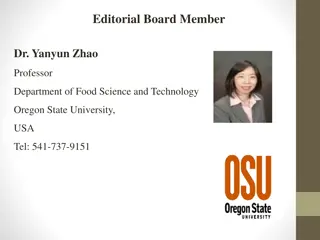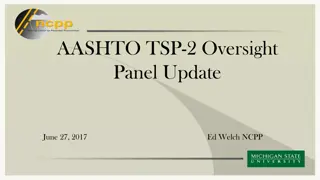Food Processing and Leftovers: Understanding Preservation Techniques
Food processing plays a crucial role in preserving and extending the shelf life of foods. This chapter explores the advantages and disadvantages of food processing, the conditions microorganisms need to grow, various methods of food preservation, guidelines for freezing food, the significance of blanching, the role of additives, convenience foods, cook-chill foods, and effectively utilizing leftovers. It also covers the impact of over-consumption of nutrients, deficiency diseases, and energy balance.
Download Presentation

Please find below an Image/Link to download the presentation.
The content on the website is provided AS IS for your information and personal use only. It may not be sold, licensed, or shared on other websites without obtaining consent from the author.If you encounter any issues during the download, it is possible that the publisher has removed the file from their server.
You are allowed to download the files provided on this website for personal or commercial use, subject to the condition that they are used lawfully. All files are the property of their respective owners.
The content on the website is provided AS IS for your information and personal use only. It may not be sold, licensed, or shared on other websites without obtaining consent from the author.
E N D
Presentation Transcript
12 Food Processing and Leftovers Learning Outcomes Chapter 12 Food Processing and Leftovers
12 Food Processing and Leftovers Key Words Food processing Food preservation Blanching Open freezing Blast freezing Expiry date Food labelling Food additives E numbers Cocktail effect (additives) Convenience foods Cook-chill foods Leftovers 2 Essentials for Living, 3rd Edition
12 Food Processing and Leftovers Learning Outcomes After completing this chapter and the homework, assignments and activities that accompany it, you should: Understand what food processing is and what its advantages and disadvantages are. Be able to list and understand the six conditions that micro-organisms need to grow. Be able to describe how this relates to each method of food preservation: freezing, applying heat, drying, canning and bottling, adding chemicals, irradiation. Understand the guidelines for successfully freezing food and put this information into practice in practical class or at home. Know what blanching is and why it is done before freezing vegetables. Know why and how some foods are open frozen and put this information Understand why we need food and be able to list the factors that influence our food choices Have a good understanding of each of the six nutrients in terms of their composition, classification, sources, functions in the body and their RDA Understand and be able to describe the effects of over-consumption of certain nutrients on the body - fat, sugar and vitamin/mineral supplements Know the nutrition related causes of the following deficiency diseases and be able to describe their symptoms - constipation and bowel disease, scurvy, rickets, neural tube defects, tooth decay, osteomalacia and osteoporosis, anaemia and goitre. Understand the term energy balance be able to describe how it can be maintained by the individual. into practice in practical class or at home. Understand the term blast freezing. 3 Essentials for Living, 3rd Edition
12 Food Processing and Leftovers Learning Outcomes Understand the rules for buying, thawing and packing frozen foods and put this information into practice. Know what information food packaging should carry by law. Understand what the E number system of coding food additives is and the facts about E numbers. Be able to name a range of additives used in food and describe the advantages and disadvantages of additives. Be able to list a range of convenience foods on the market today and describe their advantages and disadvantages. Know what cook-chill foods are and the dangers that can be associated with them. Understand and be able to describe the guidelines for using leftovers. Be able to name some dishes that can be made using leftovers. 4 Essentials for Living, 3rd Edition
12 Food Processing and Leftovers Food processing Food processing means treating foods in some way to make them easier to use. Most foods nowadays undergo some degree of processing. Advantages of food processing Processed foods usually last longer than unprocessed foods. Requires less preparation. Easier to transport. Easier to store in shops and at home. Seasonal foods are available all year round. Disadvantages of food processing Processed food is expensive. Processed food is frequently not as tasty as fresh foods. Nutritional value is often reduced. Packaging is bad for the environment. 5 Essentials for Living, 3rd Edition
12 Food Processing and Leftovers Examples of food processing Before processing After processing Wheat grains Flour Unpasteurised milk Pasteurised milk Milk Cheese Raw chicken Chicken curry, TV dinner Pork Frozen sausage rolls Fresh vegetables Packet of frozen vegetables Mandarin oranges Tin of mandarin oranges Potatoes Oven chips 6 Essentials for Living, 3rd Edition
12 Food Processing and Leftovers Food preservation Food preservation is a form of food processing that slows down food spoilage (food going bad). Food spoilage is caused by enzymes, moulds, yeast or bacteria attacking food. Spoilage of some foods, such as butter, may be caused by oxygen in the air. Enzymes, moulds, yeast and bacteria need six conditions to grow: Food Warmth Moisture Time Oxygen (most) Correct pH Take one or more of these conditions away or add a chemical preservative, such as vinegar (which is acidic and so alters pH), and the food is preserved. 7 Essentials for Living, 3rd Edition
12 Food Processing and Leftovers Advantages of preservation Preservation prevents waste, so it saves money. Seasonal foods are available all year round. It adds variety to the diet. Many preserved foods are easy to prepare, e.g. frozen vegetables. 8 Essentials for Living, 3rd Edition
12 Food Processing and Leftovers Methods of preservation 3. Drying = removing moisture. 2. Pasteurisation, canning and bottling = applying strong heat. 1. Freezing and refrigeration = removing warmth. 6. Irradiation = passing rays through foods (usually fruit and vegetables). Rays destroy enzymes and bacteria, so food keeps longer. Some scientists question the safety of this method. 5. Adding chemical preservatives, e.g. sugar, vinegar, smoke, salt or other E numbers. 4. Canning and bottling = removing air. 9 Essentials for Living, 3rd Edition
12 Food Processing and Leftovers Freezing Food is brought to a temperature of 18 C or below. Enzymes and micro-organisms are not killed at this temperature but become inactive (sleep). Once food is thawed,enzymes and micro-organisms become active again. Frozen food, if frozen properly, is almost as nutritious as fresh food. Because food is usually frozen while at its freshest and most nutritious, it is actually more nutritious than fresh food that has been lying around for a few days. 10 Essentials for Living, 3rd Edition
12 Food Processing and Leftovers Guidelines for successful freezing Turn the freezer to its coldest setting two to three hours before freezing to freeze food quickly. Freeze food at its freshest. Do not freeze too much at a time. Cool food before freezing it. Choose suitable packaging. Freeze in usable amounts. If there is a fast freeze cabinet, use it to freeze foods. Label foods clearly. 11 Essentials for Living, 3rd Edition
12 Food Processing and Leftovers Blanching Blanching destroys enzymes that can reduce the quality of frozen vegetables. Plunge prepared vegetables into boiling water for 1 4 minutes. Plunge into ice-cold water. Blanching times 1 minute Mushrooms, peas 3 minutes Beans, broccoli, cauliflower, parsnips, turnips 4 minutes Brussels sprouts, carrots 12 Essentials for Living, 3rd Edition
12 Food Processing and Leftovers Why it s important to freeze food quickly Quick freezing: Small ice crystals are formed. On thawing, cell walls of food are unbroken, food stays firm and keeps its shape. Slow freezing: Large ice crystals are formed. On thawing, food loses its shape and nutrients and becomes soft and mushy. 13 Essentials for Living, 3rd Edition
12 Food Processing and Leftovers Open and blast freezing Open freezing: Fruit and vegetables, e.g. berries or peas, that are likely to stick together are open frozen as shown above and then packed into bags. Blast freezing: This is a commercial method of freezing. Very cold air ( 35 C) is blown over food to freeze it quickly. 14 Essentials for Living, 3rd Edition
12 Food Processing and Leftovers Buying frozen foods Thawing frozen foods Packaging should not be torn. Food should be frozen solid. The shop s freezer should read 18 C or less. Check that food is below the load line in open freezers. Some foods can be cooked from frozen, e.g. burgers or chips. Read the packet instructions. Thaw meat completely, especially chicken. Food can be thawed in the microwave or in the fridge overnight. Neverrefreeze thawed food. 15 Essentials for Living, 3rd Edition
12 Food Processing and Leftovers Packaging suitable for freezing Polythene bags (freezer bags), polythene (plastic) boxes, aluminium foil and containers, waxed cartons with lids. Care should be taken to seal containers well or freezer burn will result and food will be inedible. 16 Essentials for Living, 3rd Edition
12 Food Processing and Leftovers Foods not suitable for freezing Vegetables with a high water content, e.g. cucumber or lettuce. Bananas and avocados they turn black. Whole eggs they crack (although egg white and yolk can be frozen separately). Milk, cream and mayonnaise the fat and water separate. 17 Essentials for Living, 3rd Edition
12 Food Processing and Leftovers Other methods of preservation Canning and bottling Drying Chemical preservation Enzymes and micro- organisms need moisture (water) to survive. Dehydration or drying removes moisture and so preserves the food. Examples: Breakfast cereals, pasta, rice, raisins (dried grapes), soups. Certain chemicals preserve food. Many of them are natural and have been used for centuries. Sugar, e.g. jam. Vinegar, e.g. pickles. Salt, e.g. canned fish Smoke, e.g. fish. There are also many artificial preservatives. Food is heated to a high temperature (this kills enzymes and micro-organisms). Food is then sealed in sterile containers. Food keeps for years. Vitamins B and C are lost. Do not buy damaged or bulging cans they may contain food- poisoning bacteria. 18 Essentials for Living, 3rd Edition
12 Food Processing and Leftovers Question time Use the question time answer sheets supplied on the Teacher's CD. 1. 2. 3. 4. What is meant by food processing? List four advantages of food processing. List three disadvantages of food processing. Give one example of how each of the following foods are processed: (a) wheat grains (b) milk (c) raw chicken (d) pork (e) potatoes. What is food preservation? List six conditions micro-organisms need to grow. List four advantages of food preservation. List six methods of preserving food. Outline six guidelines for successful freezing. 5. 6. 7. 8. 9. 19 Essentials for Living, 3rd Edition
12 Food Processing and Leftovers Question time Use the question time answer sheets supplied on the Teacher's CD. 10. What is the purpose of blanching foods before freezing? Describe how it is done. Why is it important to freeze foods quickly? What is open freezing? Why and how is it carried out? What is blast freezing? Suggest four guidelines for buying frozen foods. Suggest four guidelines for thawing frozen foods. Name three different types of packaging suitable for freezing. Name four foods that are not suitable for freezing. List and briefly describe three other methods of preserving food. 11. 12. 13. 14. 15. 16. 17. 18. 20 Essentials for Living, 3rd Edition
12 (Higher Level only) Food Processing and Leftovers Food labelling Under EU law, all packaged food must have certain information on the label. These items of information are illustrated below. Name of food List of ingredients: product s main ingredient (by weight) listed first, etc. Net quantity Use-by/best-before/sell- by date Storage instructions Name and address of manufacturer Country of origin Instructions for use (if necessary) Nutritional information (if product is making health claims) 21 Essentials for Living, 3rd Edition
12 (Higher Level only) Food Processing and Leftovers Food additives In 1984, the EU decided to make it law for food manufacturers to display lists of ingredients (including all additives) on food packaging. A system of coding additives was also developed and many additives were given an E number. There has been much public debate and misunderstanding about E numbers since then. Many people believe all E numbers to be a health risk, causing hyperactivity and allergic reactions. It is because of this bad press that most food labels now list additives by their full names instead of by their E numbers. 22 Essentials for Living, 3rd Edition
12 (Higher Level only) Food Processing and Leftovers What are the facts? Additives thoughtto be safe by the EU s scientific committee for food are given an E number. Many E numbers are natural healthy substances. For example, vitamin C is E300 and vinegar is E260. However, there are questions about the safety of some additives still being passed off as safe under EU regulations. Another important issue is that of the cocktail effect . This means that while individual additives may be quite safe on their own, they may not be when mixed with others. 23 Essentials for Living, 3rd Edition
12 (Higher Level only) Food Processing and Leftovers Advantages and disadvantages of additives Advantages They preserve food so that it lasts longer, thus reducing waste. They reduce the chance of food poisoning. They allow for a wider choice of foods. They improve the appearance, texture and flavour of foods. Disadvantages Some people suffer side effects from additives. People get used to the taste of foods containing additives, especially monosodium glutamate (MSG), and may then find healthy, additive-free fresh foods tasteless. While individual additives may be safe on their own, it is still unknown what the cocktail effect will be on the body. Additives can deceive consumers about food quality. 24 Essentials for Living, 3rd Edition
12 (Higher Level only) Food Processing and Leftovers Food additives and their functions Type of additive What it does Colourings (E100 E199) Make food look more appetising. Preservatives (E200 E299) Prevent food from going off, e.g. vinegar preserves pickled onions. Antioxidants (E300 E399) These prevent fats, e.g. butter, from reacting with the air and going rancid (off). Emulsifiers, stabilisers and thickening agents (E400 E499) Emulsifiers allow oil and water to mix. Stabilisers keep mixtures from separating, e.g. mayonnaise. Thickening agents are used to thicken foods, e.g. sauces, without altering the taste of the product. Starch is an example of a thickening agent. Flavourings (no E number) Add to the flavour of food, e.g. vanilla essence. Flavourings (E600+) Strengthen the flavour of food, e.g. MSG. Sweeteners Saccharin. Nutritional additives (no E number) These improve the nutritional quality of food or replace nutrients lost in processing. 25 Essentials for Living, 3rd Edition
12 Food Processing and Leftovers Convenience foods Convenience foods are foods that have been processed in some way to make them easier and quicker to use. There are a number of different types of convenience foods: 1. Foods in cans, bottles and jars 2. Frozen foods 3. Dried foods 4. Ready-to-cook foods (foods are prepared for cooking but not cooked) 5. Cook-chill foods (prepared, cooked and chilled just need reheating) 26 Essentials for Living, 3rd Edition
12 Food Processing and Leftovers Advantages of convenience foods They are quick and easy to use, especially for people with busy lifestyles or limited cooking skills. They are easy to store. Some convenience foods, e.g. frozen vegetables, are very nutritious. Many last longer and so reduce waste. Cook-chill foods often come in individual portion sizes, so are useful for people living alone, e.g. the elderly. 27 Essentials for Living, 3rd Edition
12 Food Processing and Leftovers Disadvantages of convenience foods Some convenience foods are expensive. They may contain additives. The nutritive value may be reduced during processing, e.g. canned fruit. Portion sizes may be very small. Cook-chill foods can be a source of food poisoning if not stored properly or reheated thoroughly. 28 Essentials for Living, 3rd Edition
12 Food Processing and Leftovers The dangers of cook-chill foods Because they are only reheated and not cooked again at home, cook-chill foods, can be a source of food poisoning. These foods are safe if they are stored in a fridge or freezer below 4 C and are reheated thoroughly. If a microwave is used to reheat the food, it must be stirred so that all parts of the food reach a high enough temperature. 29 Essentials for Living, 3rd Edition
12 Food Processing and Leftovers Leftovers Good meal planning should ensure that too much food is not cooked for meals. At times, however, there will be food left over. Leftovers may be eaten cold, e.g. roast chicken made into sandwiches, or reheated (r chauff ). Guidelines for using leftovers Try to serve leftovers with fresh foods, e.g. leftover chicken with a fresh salad and brown bread. Cool leftovers quickly, cover and store in the fridge. Use leftovers within two days. Reheat leftovers thoroughly, as they are a likely source of food poisoning. Never reheat leftovers twice. 30 Essentials for Living, 3rd Edition
12 Food Processing and Leftovers Dishes using leftovers Chicken: Curry, sandwiches, salads. Beef: Curry, sandwiches. Eggs: Yolks can be used to make mayonnaise or in baking. Whites can be used to make meringues or bread and butter pudding. Potatoes: Potato salad, shepherd s pie, cheese and potato pie. Bread: Stuffing, French toast, bread and butter pudding. 31 Essentials for Living, 3rd Edition
12 Food Processing and Leftovers Question time Use the question time answer sheets supplied on the Teacher's CD. (Questions 1 5 are Higher Level only) 1. List nine items of information that must appear on a food label under EU law. What are E numbers? 2. 3. 4. 5. What is meant by the cocktail effect in relation to food additives? List four advantages and four disadvantages of food additives. What is the purpose of each of the following: (a) colourings (b) preservatives (c) antioxidants (d) emulsifiers (e) flavour enhancers? Describe four different types of convenience foods. How can you help ensure cook-chill foods are safe to eat? Outline four guidelines for using leftovers. Name one leftover dish that could be made with each of the following: (a) chicken (b) eggs (c) bread. 6. 7. 8. 9. 32 Essentials for Living, 3rd Edition
12 Food Processing and Leftovers Assignment 27 Now test yourself at www.eTest.ie. 33 Essentials for Living, 3rd Edition



